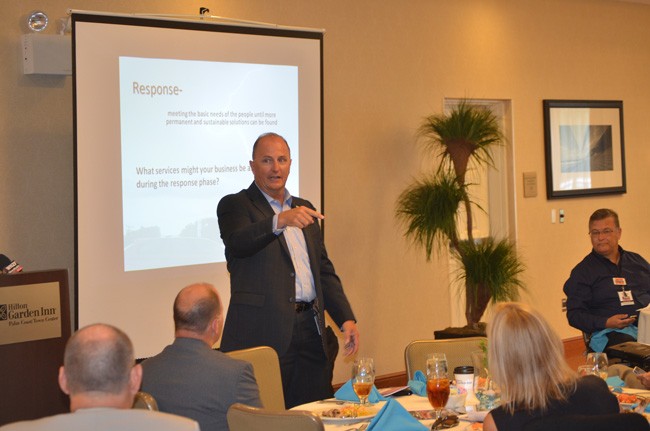
It’s been a busy 24 hours for Kevin Guthrie, Flagler County’s emergency management director. Tropical Storm Erika on Wednesday was looking as if it’d be the first storm to make landfall in Florida is a decade, and to do so somewhere south of Flagler County, prompting Guthrie’s division to open a hotline for concerned residents. This morning’s reports have eased fears of a neighboring landfall.
At noon, Guthrie was appearing before some 80 business leaders at the Hilton garden Inn for a presentation on how local business can help in the disaster-recovery process, ensuring that local businesses rather that out-f-town opportunists get the first chance to put the community back together—should something like a hurricane, a tornado or ravaging fires cause outsize destruction.
Later this afternoon, Guthrie was to be fielding media calls to address the latest from Tropical Storm Erika.
He gave today’s lunch audience a preview by starting his talk with an update on Erika, calling it a likely “bad noreastern for 36 hours in Flagler County” that will create local flooding, some storm and wind damage such as trees falling. “Just two days ago that line was coming right up the Intracoastal Waterway. That’s a really bad scenario for us,” he said. “We’ve never had that happen here in Flagler County. That doesn’t mean we need to be complacent. It only takes one.”
So with Erika churning the Leeward Islands, all attention was on what Guthrie called “Disaster Economics”–how businesses should be prepared ahead of time so than when disaster strikes, recovery time is shorter, and of course how businesses clarify to themselves and the community what services they may provide after a disaster to help the community mend in “bringing the affected area back to normalcy as quickly as possible.”
He summed up the typical necessary response to a disaster as a four-step process: life safety, scene stabilization, property conservation and social restoration.
Where communities fail is when they accomplish the first three elements but miss the fourth element, which lasts years. “The response is going to last two, three, four weeks.” The recovery “as we know it today is going to last six to 10 years,” Guthrie said, noting that such recovery efforts are still in place in new Orleans, on the 10th anniversary of Hurricane Katrina.
As far as businesses are concerned—and all but a handful of businesses in Flagler are small businesses—preparedness is key, down to being able to function during or immediately after a disaster.
“Do you know what you have to have right now to do your job?” he asked. What if the basic infrastructure of a business is wiped out: would the business owners know how they could continue to operate? Are there back-up plans? County government, for example, has just such contingency plans—where to move, what to move to keep functioning.
County government has its own plan to keep functioning during a disaster, and to do so with as few inefficiencies as possible at a time when demands on emergency services are heightened.
For example, when tropical storm winds reach 45 mph, emergency management brings in all its emergency responders “in house.” Meaning that large areas of the county are essentially shut down. When winds reach 45 mph, the barrier island is evacuated. That’s when the bridges are shut down, at least going east: the lanes remain open for people to leave the barrier island, but not to return there. The reason: “We are not going to put law enforcement officers and firefighters in harm’s way” unnecessarily, he said.
“If everything is destroyed on the other side of the ICW, we don’t want the wrong people in there,” Guthrie said.
The comes step two. The destructive factor has passed. Who gets to return to the barrier island? Residents, certain businesses and emergency responders and repair workers only—and only for a limited time: they’d be allowed in to gather some belongings, but be required to leave again.
What follows is the sort of coordination that seeks to tap local businesses’ most useful services in the immediate recovery phase: Realtors who can provide emergency spaces, repair businesses, even funeral homes that can provide emergency cold storage. “Can your service be involved in a response, and if it can, I want you to call me,” Guthrie said.
An example: maybe Sally’s Ice Cream in Flagler Beach can;t function in Flagler Beach. But it could possibly provide a different food service—it could make burgers—and prepare them for the sheriff’s office’s two shifts of 135-odd deputies. “If I’ve got a local vendor that’s taking care of all of my food for local responders, why would I want to contract with someone from” Texas, Guthrie said.
In the long term, the county cannot afford to lose its small businesses after a disaster, he said: the economic engine locally must be regenerated as quickly as possible, or too many businesses will move out, and the local economy will suffer.
Take heed of what Kevin says, because the longer we go without one,” Garry Lubi, the Ameris Bank executive and executive board member of the Flagler chamber of commerce–which sponsored the lunch–“the more our memory fades.”





























Algernon says
Great program with 75 people in attendance. Thanks to the Chamber for putting on this event!
Kevin Guthire was VERY informative!